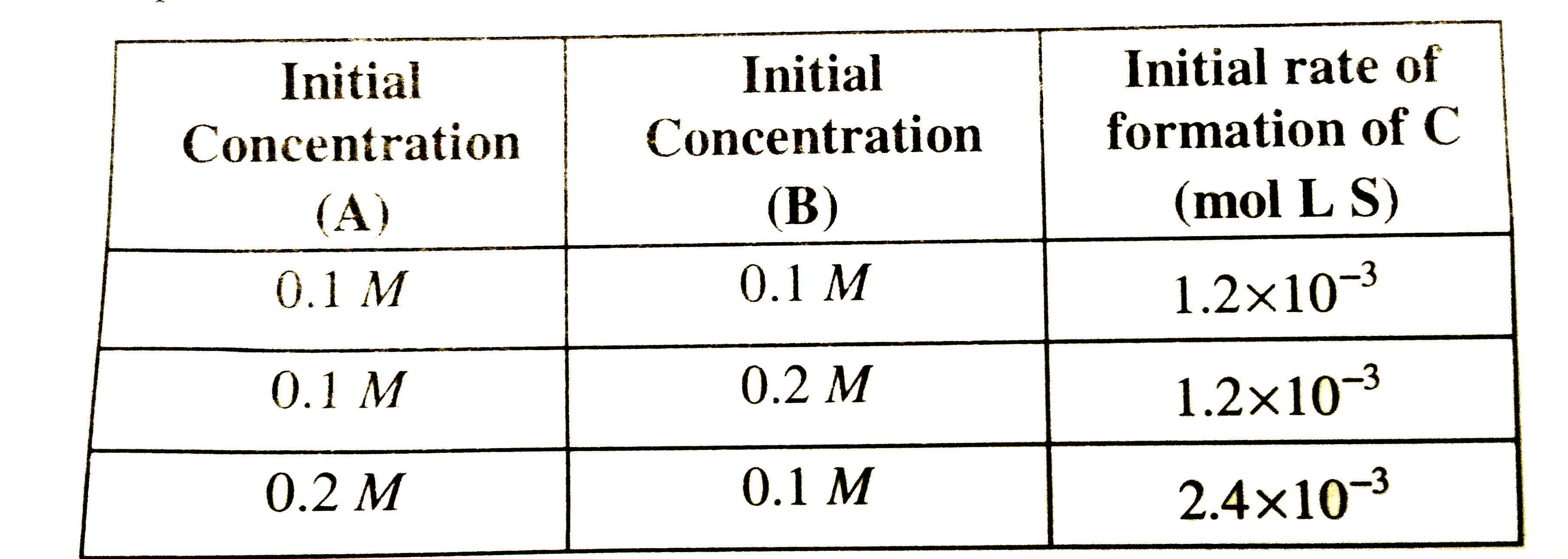For the non -stoichiometric reaction 2A+B→C+D, the following kinetic data were obtained in three separate experiments , all at 298K.

The rate law for the formation of C is -
dCdt=k[A]
dCdt=k[A][B]
dCdt=k[A]2[B]
dCdt=k[A][B]2
The correct Answer is:A
For the reaction: 2A+B→C+D
Rate =−12d[A]dt=−d[B]dt=d[C]dt=d[D]dt
Suppose , rate formation of C, d[C]dt=k[A]x[B]y
So, 1.2×10−3=k(0.1)x(0.1)y ...[1]
1.2×10−3=k(0.1)x(0.2)y ...[2]
2.4×10−3=k(0.2)x(0.1)y ...[3]
Dividing (1) by (2) , we get
or, 1=(12)y
∴y=0
Dividing (1) by (3), we get
∴1.2×10−32.4×10−3=k(0.1)x(0.1)yk(0.2)x(0.1)y
or, (12)1=(12)x
or, x = 1
∴d[C]dt=k[A]1[B]0=k[A]
Topper's Solved these Questions
- CHEMICAL KINETICSBOOK - CHHAYA PUBLICATIONCHAPTER - CHEMICAL KINETICSEXERCISE - ENTRANCE Question Bank (NEET)
14 Videos
- CHEMICAL KINETICSBOOK - CHHAYA PUBLICATIONCHAPTER - CHEMICAL KINETICSEXERCISE - ENTRANCE Question Bank (AIIMS)
14 Videos
- CHEMICAL KINETICSBOOK - CHHAYA PUBLICATIONCHAPTER - CHEMICAL KINETICSEXERCISE - ENTRANCE Question Bank (WBJEE)
9 Videos
- BIOMOLECULESBOOK - CHHAYA PUBLICATIONCHAPTER - BIOMOLECULESEXERCISE - Practic Set 29
1 Videos
- CHEMICAL THERMODYNAMICSBOOK - CHHAYA PUBLICATIONCHAPTER - CHEMICAL THERMODYNAMICSEXERCISE - Practice Set 6
15 Videos
Similar Questions
For the non – stoichiometre reaction 2A+B→C+D , the following kinetic data were obtained in three separate experiments, all at 298 K

The rate law for the formation of C is:
View SolutionFor the non-stoichiometric reaction 2A+B→C+D, The following data were obtained in three separate experiments, all at 298 K.

The rate law for the formation of C is:
View Solution
Knowledge Check
For the non-stoichiometric reaction 2A+B→C+D, The following data were obtained in three separate experiments, all at 298 K.

The rate law for the formation of C is:Adcdt=k[A][B]Bdcdt=k[A]2[B]Cdcdt=k[A][B]2Ddcdt=k[A]For the non-stoichiometric reaction:
2A+B→C+D, the following kinetic data were obtained in three separate experiments, all 298 K

The rate law for the formation of C is:AdCdt=k[A]BdCdt=k[A][B]CdCdt=k[A]2[B]DdCdt=k[A][B]2For the non-stoichiometric reaction 2A+B→C+D
The following kinetic data were obtained in theee separate experiment, all at 98K
∣∣ ∣ ∣ ∣ ∣∣Initial concentration (A)Initial concentration (B)Initial rate of formation of C(molL−1s−1)0.01M0.1M1.2×10−30.1M0.2M1.2×10−30.2M0.1M2.4×10−3∣∣ ∣ ∣ ∣ ∣∣
The rate law for the formation of C is:Adcdt=K[A][B]2Bdcdt=k[A]Cdcdt=k[A][B]Ddcdt=k[A]2[B]
For the non-stoichiometre reaction 2A+B→C+D , the following kinetic data were obtained in three separate experiments , all at 298 K

The rate law for the formation of C is
View SolutionFor the non-stoichiometric reaction 2A+B→C+D, The following data were obtained in three separate experiments, all at 298 K.

The rate law for the formation of C is:
View SolutionFor the non-stoichiometric reaction 2A+B→C+D, The following data were obtained in three separate experiments, all at 298 K.

The rate law for the formation of C is:
View SolutionFor the non-stoichiometric reaction:
A+B→C+D, the following kinetic data were obtained in three separate experiments, all at 298K.

The order of the reaction is.
View SolutionFor the non-stoichiometric reaction 2A+B→C+D
The following kinetic data were obtained in theee separate experiment, all at 98K
∣∣ ∣ ∣ ∣ ∣∣Initial concentration (A)Initial concentration (B)Initial rate of formation of C(molL−1s−1)0.01M0.1M1.2×10−30.1M0.2M1.2×10−30.2M0.1M2.4×10−3∣∣ ∣ ∣ ∣ ∣∣
The rate law for the formation of C is:
View Solution
